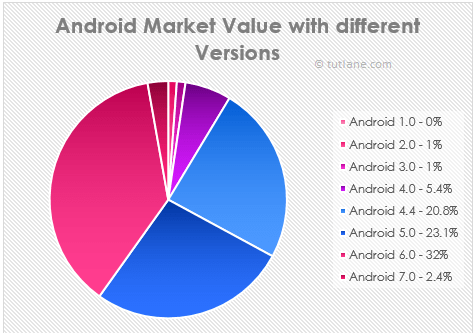Here we will learn the basics of android OS like what is android, history of the android operating system, features of android OS, different versions of the android operating system with examples.
Android is an open-source operating system based on Linux with a Java programming interface for mobile devices such as Smartphone (Touch Screen Devices who supports Android OS) as well for Tablets too.
Android was developed by the Open Handset Alliance (OHA), which is led by Google. The Open Handset Alliance (OHA) is a consortium of multiple companies like Samsung, Sony, Intel and many more to provide services and deploy handsets using the android platform.
In 2007, Google released a first beta version of the Android Software Development Kit (SDK) and the first commercial version of Android 1.0 (with name Alpha), was released in September 2008.
In 2012, Google released another version of android, 4.1 Jelly Bean. It’s an incremental update and it improved a lot in terms of the user interface, functionality, and performance.
In 2014, Google announced another Latest Version, 5.0 Lollipop. In Lollipop version Google completely revamped the UI by using Material Designs, which is good for the User Interface as well for the themes related.
All the source code for Android is available free on Git-Hub, Stack overflow, and many more websites. Google publishes most of the code under the Apache License version 2.0.
Android is a powerful open-source operating system which provides a lot of great features, those are
Initially, Google launched the first version of Android platform on Nov 5, 2007, from that onwards Google released a lot of android versions under a codename based on desserts, such as Apple Pie, Banana Bread, Cupcake, Donut, Éclair, Froyo, Gingerbread, Jellybeans, Kitkat, Lollipop, marshmallow, etc. and made a lot of changes and additions to the android platform.
The following table lists the different version details of android which is released by Google from 2007 to till date.
| Release Date | Version | API Level | Version Name |
|---|---|---|---|
| September 23, 2008 | Android 1.0 | 1 | Apple Pie |
| February 9, 2009 | Android 1.1 | 2 | Banana Bread |
| April 30, 2009 | Android 1.5 | 3 | Cupcake |
| September 15, 2009 | Android 1.6 | 4 | Donut |
| October 26, 2009 | Android 2.0 | 5 | Eclair |
| December 3, 2009 | Android 2.0.1 | 6 | |
| January 12, 2009 | Android 2.1 | 7 | |
| May 20, 2010 | Android 2.2 | 8 | Froyo |
| January 18, 2011 | Android 2.2.1 | 8 | |
| January 22, 2011 | Android 2.2.2 | 8 | |
| November 21, 2011 | Android 2.2.3 | 8 | |
| December 6, 2010 | Android 2.3 | 9 | Gingerbread |
| February 9, 2011 | Android 2.3.1 | 9 | |
| July 25, 2011 | Android 2.3.3 | 10 | |
| September 2, 2011 | Android 2.3.4 | 10 | |
| February 22, 2011 | Android 3.0.x | 11 | Honeycomb |
| May 10, 2011 | Android 3.1.x | 12 | |
| July 15, 2011 | Android 3.2.x | 13 | |
| October 18,2011 | Android 4.0 | 14 | Ice Cream Sandwich |
| October 19, 2011 | Android 4.0.1 | 14 | |
| November 28, 2011 | Android 4.0.2 | 14 | |
| December 16, 2011 | Android 4.0.3 | 15 | |
| February 4, 2012 | Android 4.0.4 | 15 | |
| July 9, 2012 | Android 4.1 | 16 | Jelly Bean |
| July 23, 2012 | Android 4.1.1 | 16 | |
| October 9, 2012 | Android 4.1.2 | 16 | |
| November 13, 2012 | Android 4.2 | 17 | |
| November 27, 2012 | Android 4.2.1 | 17 | |
| February 11, 2013 | Android 4.2.2 | 17 | |
| July 24, 2013 | Android 4.3 | 18 | |
| October 31, 2013 | Android 4.4 | 19 | Kitkat |
| June 23, 2014 | Android 4.4.1, 4.4.2, 4.4.3, 4.4.4 | 19 | |
| October 17, 2014 | Android 5.0 | 21 | Lollipop |
| March 09, 2015 | Android 5.1 | 22 | |
| October 5, 2015 | Android 6.0 | 23 | Marshmallow |
| December 7, 2015 | Android 6.0.1 | 23 | |
| August 22, 2016 | Android 7.0 | 24 | Nougat |
| October 4, 2016 | Android 7.1 | 25 | |
| Android 8.0 | 26 | O |
For each version, Google has made a lot of changes and introduced a lot of new features due to the usage of android in the mobile market increased drastically.
Following is the pictorial representation of using an android in the mobile phone market with different versions.

This is how Google released multiple versions of the android operating system and acquired a huge mobile phone market share with different versions.